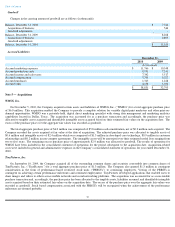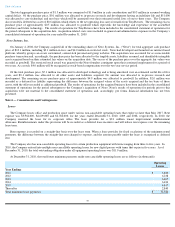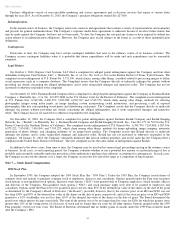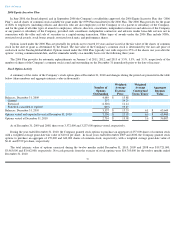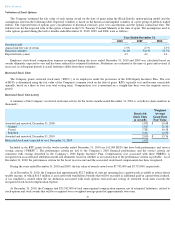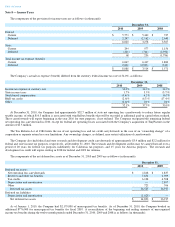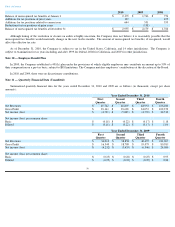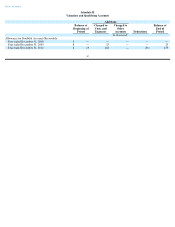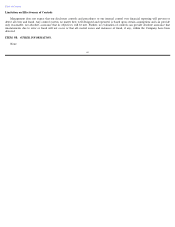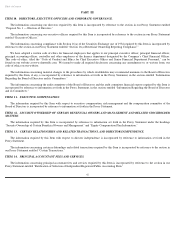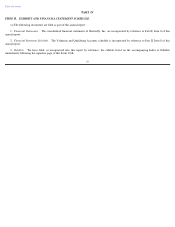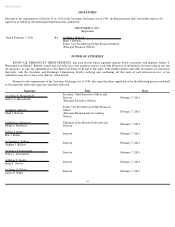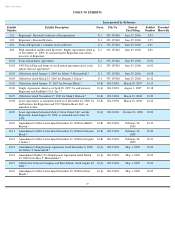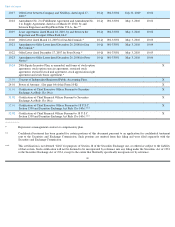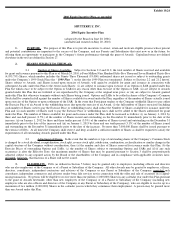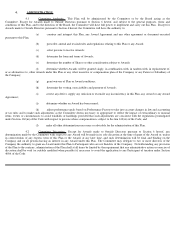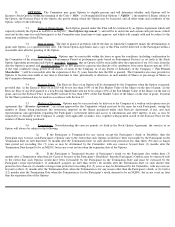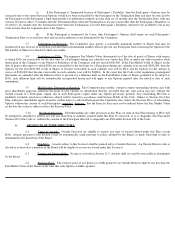Shutterfly 2011 Annual Report Download - page 71
Download and view the complete annual report
Please find page 71 of the 2011 Shutterfly annual report below. You can navigate through the pages in the report by either clicking on the pages listed below, or by using the keyword search tool below to find specific information within the annual report.
ITEM 9. CHANGES IN AND DISAGREEMENTS WITH ACCOUNTANTS ON ACCOUNTING AND FINANCIAL DISCLOSURE.
Not applicable.
ITEM 9A. CONTROLS AND PROCEDURES.
Evaluation of Disclosure Controls and Procedures
Our management, with the participation of our Chief Executive Officer and Chief Financial Officer, evaluated the effectiveness of our
disclosure controls and procedures as of December 31, 2010. The term “disclosure controls and procedures,” as defined in Rules 13a-
15(e) and
15d-15(e) under the Securities Exchange Act of 1934, (“Exchange Act”),
means controls and other procedures of a company that are designed to
ensure that information required to be disclosed by a company in the reports that it files or submits under the Exchange Act is recorded,
processed, summarized and reported within the time periods specified in the SEC’
s rules and forms. Disclosure controls and procedures include,
without limitation, controls and procedures designed to ensure that information required to be disclosed by a company in the reports that it files
or submits under the Exchange Act is accumulated and communicated to the company’
s management, including its principal executive and
principal financial officers, as appropriate to allow timely decisions regarding required disclosure. Management recognizes that any controls and
procedures, no matter how well designed and operated, can provide only reasonable assurance of achieving their objectives and management
necessarily applies its judgment in evaluating the cost-benefit relationship of possible controls and procedures.
Our management, with the participation of the Chief Executive Officer and Chief Financial Officer, has evaluated the effectiveness of the
Company’s disclosure controls and procedures as of the end of the period covered by this annual report on Form 10-
K. Based upon that
evaluation, our Chief Executive Officer and Chief Financial Officer have concluded that, as of December 31, 2010, our disclosure controls and
procedures were effective at the reasonable assurance level.
Management’s Report on Internal Control over Financial Reporting
Management of the Company is responsible for establishing and maintaining adequate internal control over financial reporting as defined in
Rules 13a-15(f) and 15(d)-15(f) under the Exchange Act. The Company’
s internal control over financial reporting is a process designed by, or
under the supervision of, our Chief Executive Officer and Chief Financial Officer, and effected by our board of directors, management and other
personnel, to provide reasonable assurance regarding the reliability of financial reporting and the preparation of financial statements for external
purposes in accordance with generally accepted accounting principles. Internal control over financial reporting includes those policies and
procedures that:
Because of its inherent limitations, internal control over financial reporting may not prevent or detect all misstatements. Also, projections of
any evaluation of effectiveness to future periods are subject to the risk that controls may become inadequate because of changes in conditions or
that the degree of compliance with the policies or procedures may change over time.
Our management, under the supervision of our Chief Executive Officer and Chief Financial Officer, conducted an evaluation of the
effectiveness of our internal control over financial reporting based on the framework in Internal Control—
Integrated Framework, issued by the
Committee of Sponsoring Organizations of the Treadway Commission. Based on this evaluation, management concluded that our internal
control over financial reporting was effective as of December 31, 2010.
The Company reviewed the results of management’
s assessment with the Audit Committee of the Board of Directors. The effectiveness of
the Company's internal control over financial reporting as of December 31, 2010 has been audited by PricewaterhouseCoopers LLP, an
independent registered public accounting firm, as stated in their report which appears herein.
Changes in Internal Control Over Financial Reporting
There were no changes in our internal control over financial reporting during the quarter ended December 31, 2010 that materially affected,
or are reasonable likely to materially affect, our internal control over financial reporting.
Table of Contents
•
pertain to the maintenance of records that, in reasonable detail, accurately and fairly reflect the transactions and dispositions of the
assets of the Company;
•
provide reasonable assurance that transactions are recorded as necessary to permit preparation of financial statements in accordance
with generally accepted accounting principles, and that receipts and expenditures of the Company are being made only in accordance
with authorizations of management and directors of the Company; and
• provide reasonable assurance regarding prevention or timely detection of unauthorized acquisition, use or disposition of the Company’
s
assets that could have a material effect on the financial statements.
60


